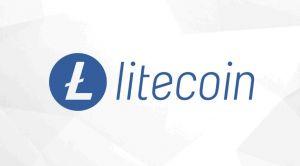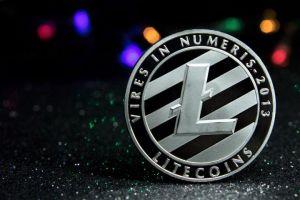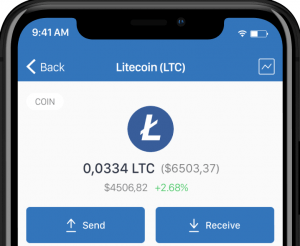LTC
Litecoin
Designed as an answer to Bitcoin’s perceived shortcomings, Litecoin is promoted as the cryptocurrency offering faster transactions, lower fees and higher numbers of coins in circulation.
| Market Cap | Volume 24h | Circulating Supply | Maximum Supply |
|---|---|---|---|
| $3,979,940,043 | $626,504,942.49 | 71607606.0 LTC | 84000000.0 LTC |

What Is Litecoin?
Despite describing itself as “lite” in its name, Litecoin was actually designed to take on cryptocurrency heavyweights, particularly Bitcoin. One can say that Bitcoin’s shadow hovers above many of Litecoin’s features which were developed in response to what was perceived as failing of the core model used by the world’s first mainstream crypto.
Litecoin (LTC) is the native crypto of the Litecoin platform which went live in October 2011. Charlie Lee, a former Google’s employee, and his colleagues created Litecoin as a “software fork” of Bitcoin core client. While it does not share a common transaction history (which is the case in both hard and soft forks) with it, it is still based on Bitcoin’s code. Lee’s main ambition revolved around creating a global decentralized payment network similar to Bitcoin, which would perform its role without shortcomings supposedly plaguing Bitcoin. Lee summarized this by claiming that Litecoin will be called the “silver to Bitcoin’s gold”.
What Is Litecoin Trying to Achieve?
Comparison between silver and gold should come as no surprise, as Litecoin aims to move away from the reported value hoarding model to becoming a decentralized medium of transferring value for practical and everyday use.
The Litecoin developers consider speed performance a key factor in promoting adoption of cryptocurrencies by the mainstream audience. For starters, Lee and his team consider Bitcoin too slow for regular and frequent transactions, meaning that its approximate 10 minute confirmation time and associated average 7 transactions per minute do not cut it anymore, according to them. In addition, the Bitcoin network’s growth in size is described as not delivering a parallel increase in performance, creating issues with scalability and bottlenecks.
Litecoin’s network is designed to verify transactions at a faster pace. Litecoin took on Bitcoin in this segment, with its average verification periods taking about two and a half minutes, meaning that it can form up to four equally sized blocks in the time span in which a single Bitcoin block is confirmed. Paired with the Litecoin’s implementation of Lightning Network and Segregated Witness (SegWit), the developers hope that this feature should make Litecoin a viable payment option for both the merchants and regular users.
- Trying to beat Bitcoin at its own game meant that Litecoin had to go for cheaper transaction rates. Rising transactions fees were identified as yet another issue with Bitcoin. As an alternative, Litecoin proposed bringing the same or better functionality at lower costs and reduced dependence on peak traffic price spikes. With Litecoin, the transaction fees are closely linked to the size of a transaction and the block size involved, leaving the transaction amount out of the calculation. In early 2019, its rate for each KB amounted to some USD 0.05. Yet, the developers promise that new upgrades to the Litecoin should reduce these fees to approximately USD 0.005, starting from the one launched in May 2019. All of this should make Litecoin more acceptable to people who feel that transaction fees for small daily purchases such as groceries simply add up too fast.
Over time, Litecoin has focused more on privacy, adding the pledge to protect anonymity to the list of its priorities. Feeling that the lack of privacy features with both Bitcoin and Litecoin hampers their prospects, Charlie Lee designated 2019 as the year in which Litecoin will start exploring new territories when it comes to improving its privacy features. Confidential Transactions are a planned new feature for the Litecoin network, with an option to have these implemented via soft forks instead of the hard ones. Some of the efforts to be undertaken by Litecoin in this segment involve finding ways to integrate the Mimblewimble protocol with the help of the team behind the Beam coin. Once fully implemented, the technology will allow for on-chain conversion of regular LTC into its Mimblewimble variant and vice versa.
To allow LTC to compete with the likes of Monero and Zcash on more even terms, Litecoin plans to emulate MimbleWimble’s innovation called CoinJoin, which allows for combining multiple payment information to create a single transaction chain. This would result in having payments whose origins and destinations are obfuscated to any outside parties. This implementation by LTC should offer better confidentiality of transactions made with this currency. The developers also claim that this should not affect the Litecoin’s Lightning Network compatibility.
Litecoin aims to deliver a higher level of integration with various industries. Cross-industry integration is yet another promotional hallmark of Litecoin which its developers want to turn into the currency’s strengths. The platform aims to operate akin to an open software, which is freely accepting technological improvements while choosing not to neglect a loyal community built around it. In exchange for their support, Litecoin developers have secured strong support for the currency on cryptocurrency exchanges and working with a web of merchants using Litecoin in the fields ranging from art to gambling and clothing.
In mid-2019, Litecoin’s availability was given additional boost - the New York-based payment startup Flexa launched its network for cryptocurrency payments that allows users to spend cryptocurrency in multiple stores. Since July 2019, Litecoin went live on Flexa in partnership with the Litecoin Foundation, supporting point-of-sale payments with LTC at more than 39 000 stores across the US. This development goes hand in hand with Litecoin’s ongoing efforts to receive wider acceptance among a broader range of cryptocurrency exchanges, developers, ATM providers, casinos, etc.

How Does Litecoin Plan to Deliver on Its Fungibility Promise?
In addition to privacy, the collaboration between Litecoin and privacy coin Beam is supposed to help the LTC strengthen its bid to deliver fungibility as the only feature of “sound money” that is supposedly missing from both Bitcoin and Litecoin, according to the Litecoin founder Charlie Lee. The goal is to have all Litecoin tokens in circulation have the same value, as newly created tokens are sometimes considered more valuable compared to those that have been used in illegal operations.
To prevent the existence of “tainted” coins, the Litecoin’s team pin their hopes on what is already planned for their Confidential Transaction feature, set to be implemented in late 2019. With it, the recipients of the specific funds can decide not to accept the transaction based on its earlier history and refuse to do business with suspect parties altogether.
How Do Litecoin’s Atomic Swaps Work?
One of Litecoin’s flagship features is its support for atomic swaps which allow for the exchange of tokens across chains with no need for intermediaries. This eliminates the need to go through exchanges and pay their fees for the simple operations involving exchanging LTC for other cryptos.
Based on Litecoin’s implementation of this technology, the currencies will be just swapped, with the help of the platform hashed timelock contracts (HTLCs). Instead of the standard channels which use timelocks, the HTLC upgrades these by introducing so-called hashlocks to the mixture. They enable the operation of payment channels which support transactions verified by means of cryptographic proofs. In addition, parties to a transaction can forfeit payment at any time and send it back to the paying party.
How Does Litecoin Plan to Fortify Its Security?
Making the Litecoin more resistant to flood attacks is promoted as one of this currency’s strengths. These attacks involved flooding a network with spam transactions, causing the blocks to fill up and overwhelm the blockchain. In the case of Bitcoin, one attack of this type from July 2015 involved flooding the mempool and causing significant delays in processing regular transactions.
Litecoin aims to combat these by making these attacks economically unreasonable. This will be done by charging a sender a fee for each minuscule output that is created. Based on the patch introduced to Litecoin after the attack on Bitcoin, the cost of performing this spam attack would actually outweigh any potential gain for the spammer.

Mining Litecoin
Litecoin is designed to support a more even distribution of hash power compared to Bitcoin. Applied to mining pools and even the smallest groups of miners, this should help the platform achieved the desired level of mining decentralization.
In addition to this, Litecoin implements the Scrypt hashing algorithm which arguably demands less processing power compared to Bitcoin’s SHA-256. Scrypt also supports higher levels of parallel processing and prevents the use of Application-Specific Integrated Circuits (ASICs) and associated mining hardware, allowing Litecoin to prevent the domination of a single miner or a particularly powerful mining group, while opening the door to more miners from the outset.
In august 2019, Litecoin underwent its second halving, meaning that its rate of new coin supply is now half of what it was – down from LTC 25 to LTC 12.5 per mined Litecoin blockchain block. The currency’s first halving took place on August 25, 2015, when the Litecoin block mining reward was reduced from LTC 50 to 25 LTC. While halving is meant to slow issuance in order to make LTCs less exposed to inflation, the traders can usually expect a period of increased volatility, while the miners will be earning lower rewards. The next halving is planned to take place in August 2023.
Litecoin Availability
As of September 2019, more than 63 million LTC tokens were found in circulation, out of its max supply of 84 million units. At the same time, the currency’s market cap stood at more than USD 4 billion, placing the currency in the top 5 coin club based on its value.
LTCs are readily available for trading on various cryptocurrency exchanges, including Binance and CoinSmart. Acquired tokens can be stored in the officially supported wallet available for Windows, Linux and Mac platforms.
Litecoin News
Find the latest Litecoin news here.
